Signatures of proximity induced p-wave superconductivity in dual topological insulators
NISE Seminar
- Datum: 18.09.2024
- Uhrzeit: 10:30 - 11:30
- Vortragender: P. S. Anil Kumar
- Department of Physics, Indian Institute of Science, Bangalore 560012 INDIA
- Ort: Max-Planck-Institut für Mikrostrukturphysik, Weinberg 2, 06120 Halle (Saale)
- Raum: Lecture Hall, B.1.11

Quantum materials display novel electronic phenomena arising from reduced dimensionality, quantum confinement, topology of wave functions, and other factors. These materials, such as graphene, topological insulators (TIs), Weyl semimetals, spin-liquids, and others, have attracted extensive research interest from condensed matter physicists and materials scientists in recent decades, as they offer promising prospects for the next generation of electronic devices due to their superior properties. The emergence of TIs and semimetals has opened a new realm of low-energy electronic devices that enable dissipationless transport through their highly spin-orbit coupled conducting channels. Dual TIs possess two different topological surface states protected by symmetries. BiTe, a dual TI with a superlattice structure, exhibits both weak and crystalline topological phases at different facets. By employing Scanning Tunnelling Microscopy and Spectroscopy, we identified a Dirac point within the band gap at the top surface, which originates from topological crystalline states. Furthermore, we detected enhanced differential conductance only at the step-edges that contain Bismuth bilayers, corresponding to one-dimensional conducting channels of weak topological surface states. It has been theoretically predicted that introducing superconducting correlations into topological surface states of TIs could result in topological superconductivity, potentially hosting the elusive Majorana fermions. These particles may enable fault-tolerant quantum computing via the realization of topologically protected qubits. Here, we present signatures of p-wave superconductivity at the BiTe/s-wave superconductor (NbSe2) heterojunction through a series of electrical transport measurements. Four-terminal differential conductance measurements at low temperatures reveal distinctive features such as a sharp V-shaped zero-bias dip and convex-shaped coherence peaks. Fitting the differential conductance using a multiband 2-D Blonder-Tinkham-Klapwijk (BTK) model reveals two different superconducting gaps with anisotropic p-wave and s-wave characteristics, respectively. Differential conductance measurements at various magnetic field orientations indicate that the superconductivity in this system is sensitive to the direction of the applied magnetic field.
*In collaboration with, Abhinab Mohapatra, Gagan Rastogi and K.K. Ambili